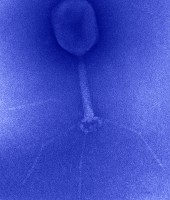Symbiotic viruses
Study day organised by Benjamin Hegarty, medical anthropologist, Senior Research associate at Kirby Institute, UNSW Syndey, Research afiliate at Oxford University, and 2024-2025 research-fellow the Paris IAS (FIAS program) and Frédéric Keck, CNRS Research Director and Director of the Laboratory of Social Anthropology.
For this study day, a few places are open to the public, on request, directly from Benjamin Hegarty (bhegarty@kirby.unsw.edu.au).
Only the 1:30 - 2:45 pm outdoor session is largely open to the public: please register using the registration form at the bottom of the page.
Presentation
In the wake of their lecture The science of viruses: symbiotic possibilities on the 4th of March, 2025 at the Collège de France, Benjamin Hegarty and Frédéric Keck are organising a study day devoted to specialists in the field of viruses, their life and evolution, and their interactions within environments and with human and non-human species.
Program
9am - 9.30am: Welcome
9.30am - 11am: Interspecies relations
Interspecies mixing has been a key target of surveillance and pandemic preparedness, focused intensively on risks of ‘zoonotic spillover,’ when viruses that commonly circulate among non-human animals are passed to a human host. The techniques and practices associated with ‘emerging infectious diseases’ have focused on intensifying boundaries between humans and non-humans. The complex ecological, social, and epidemiological factors that transform non-human viruses into virulent pathogens require a detailed understanding of interspecies relations in the contemporary world.
- Hervé Bourhy (Institut Pasteur)
- Nan Nan (Laboratory of Social Anthropology)
- Jules Villa (Institut Pasteur)
11am - 11.30am: Break
11.30am - 1pm: Ecological perspectives on viruses
Viruses offer new perspectives on the environment. These perspectives, formalized by disease ecology, highlight that environmental changes can alter relations between viruses and its hosts. An ecological perspective on viruses, including the potential impact of changes in relations between human and non-human animals, can help us understand how symbiotic viruses become pathogenic in changing ecological conditions at the planetary scale.
- Eben Kirskey (Oxford University)
- Tamara Gilles-Vernick (Institut Pasteur)
- Camille Besombes (Sciences Po)
1pm - 1.30pm: Lunch
1.30pm - 2.45pm: Sensing microbial futures for the river Seine [in front of the Paris IAS]
Note only this part of the 5th of March is open to all, please register via the link below
Among the fish, eels, insects, frogs, and plants, viruses are likely the most numerous agents in the Seine river. This includes pathogens that cause diseases, like noroviruses (NoV) but it also includes good or harmless viruses, including bacteriophages, viruses that eat bacteria. Some of these viruses specifically target pathogenic bacteria like E. coli, and have been used in microbial surveillance since the early 20th century.
After taking a sample of the water of the river Seine, and contemplating its viral composition, the artist Pei-Ying Lin will provide a speculative narrative about viral relations through a dialogue with the historian Claas Kirchhelle. It will conclude with a picnic of oysters and fermented foods, inviting new appreciation of the role of microbes, including viruses, in shaping the links between ecologies and metabolism. How can we sense viruses so that we can learn about the shared histories and futures of microbial life for Seine river ecologies?
- Benjamin Hegarty (Kirby Institute, UNSW Sydney, Oxford University, Paris IAS)
- Claas Kirchhelle (CERMES3)
- Pei-Ying Lin (designer and artist)
- Joanna Wong and Christy Nguyen (Collectif Enoki)
2.45 - 4.15pm: Viruses, therapeutics and immunity
Understanding viruses has played a central role in the development of therapeutics and in concepts of immunity, and led to recognizing their complex role beyond pathogens. Although already identified in the early 20th century in Paris by bacteriologist Felix d’Herelle, bacteriophages (bacteria-eating viruses) have recently been revisited as therapies for anti-microbial resistance. Reflecting on the therapeutic possibilities of viruses can reveal more dynamic possibilities for host-virus-environment relations and the infrastructures that make them possible.
- Charlotte Brives (CNRS, University of Bordeaux)
- Beth Greenhough (Oxford University)
- Claas Kirchhelle (CERMES3)
- Benjamin Hegarty (Kirby Institute, UNSW Sydney, Oxford University, Paris IAS) and Eben Kirskey (Oxford University)
4.15pm - 4.30pm: Break
4.30pm - 5.30pm: Global health and symbiotic viruses
Although metaphors of ‘war on viruses’ persist, virologists and others have long held that viruses should be thought on less antagonistic terms. As Nobel-prize winning geneticist Joshua Lederberg argued, ‘the very essence of the virus is its fundamental entanglement with the genetic and metabolic machinery of the host.’ Seeing viruses from a symbiotic perspective can help to chart alternative perspectives on the history and future of global and planetary health.
- Jean-Paul Gaudillière (CERMES3)
- Guillaume Lachenal (Sciences Po)
- Christos Lynteris (University of St Andrews)
Practical info
Registration for outdoor activities: please fill in the form below
|
|
|
Symbiotic viruses: More-than-human anthropology, queer theory, and virology 01 September 2024 - 30 June 2025 |
|
|

